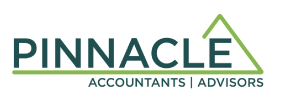
Pinnacle’s Recommended Reading
Pinnacle PAC knows that leaders are readers. The Pinnacle Team endeavors to constantly nurture our minds, expand and enhance our services, and remain thought and practice leaders in the accounting industry. We have assembled an ever-growing list of books that we feel are worthy of your time and attention.
1. The Emyth Revisited – by Michael Gerber
The E-Myth, or Entrepreneurial Myth, says that most new businesses are not started by entrepreneurs who set out to build a strong business but by technicians who enjoy the hands-on work themselves. Because of that natural bias, most business owners focus on working in their business when really they should be working on their business.
There is, however, a simple and effective way to offset the E-Myth tendency. Instead of looking at the business as a one-off operation, the owner should consider the business to be a prototype for a large number of franchises that will be added at a later stage. By adopting that mindset, the business owner will not only participate in the business as a technician but will also act as a manager (putting systems in place and controls) and as an entrepreneur (having a vision of how the business can create sustainable added-value for all key stakeholders). A business that is built and managed by someone who combines the approach of the technician, the manager and the entrepreneur will have a far greater chance of future success than one guided by someone thinking like a technician alone.
2. The 7 Habits of Highly Effective People – by Stephen R. Covey
According to Stephen Covey, to live with security and wisdom, and to have the power to take advantages of the opportunities that change creates, we need fairness, integrity, honesty and human dignity. Quite a tall order when you consider that most of us live our lives in a permanent state of flux, questioning our ideals and values and fighting a daily battle with the lack of self-confidence that stops us from taking risks of any kind. But, in The Seven Habits of Highly Effective People, Covey manages to make it sound as if changing the way we look at ourselves and the world around us so that we can become more successful both personally and professionally a reasonable endeavor.
He defines the “habits” as “the intersection of knowledge, skill and desire” and states that the “Seven Habits” of the title are not mutually exclusive, but rather when developed together help to form a well-rounded, sensitive, confident and effective human being.
3. Getting Naked – by Patrick Lencioni
Getting Naked tells the remarkable story of a management consultant who is trying desperately to merge two firms with very different approaches to serving clients. One relies on vulnerability and complete transparency; the other focuses on proving its competence and protecting its reputation for intellectual prowess. In the process of managing the merger, the consultant is forced to learn life-changing lessons that prove to be as relevant as they are painful.
4. The Four Hour Work Week – by Timothy Ferriss
Forget the old concept of retirement and the rest of the deferred-life plan–there is no need to wait and every reason not to, especially in unpredictable economic times. Whether your dream is escaping the rat race, experiencing high-end world travel, earning a monthly five-figure income with zero management, or just living more and working less, The 4-Hour Workweek is the blueprint.
5. The Firm of the Future – by Paul Dunn and Ron Baker
The professional service accounting firm is being threatened by a variety of factors: new technology, intense competition, consolidation, an inability to incorporate new services into a business strategy, and the erosion of public trust, just to name a few. At the same time, most experts agree that morale in the financial services industry is at an all-time low–an astonishing number of professionals respond in surveys that, if they had to choose their career over again, they would choose another line of work. What happened? How have the once distinguished and proud professions become so beleaguered, and is there any relief for those professionals who refuse to worship the capricious god of the almighty billable hour?
There is relief. And promise. And hope. In The Firm of the Future: A Guide for Accountants, Lawyers, and Other Professional Services, visionaries Paul Dunn and Ron Baker confront the tired, conventional wisdom that continues to fail its adherents, and present bold, proven strategies for restoring vitality and dynamism to the professional service firm. A cornerstone of Dunn and Baker’s program is conducting successful transitions to new services that customers value, treating functions such as consulting as extensions, not alternatives, to traditional services. This, however, is only part of a framework aimed at liberating professionals from mechanically pursuing billable hours ad infinitum. Dunn and Baker provide proven strategies for pricing in accordance with value and develop leading Key Performance Indicators that measure success the same way customers do. The authors articulate a new theory of the professional service firm that focuses on the real factors of leverage for the firm of the future, and which tosses the antiquated theory of leveraging people and hours onto the ash heap of history. Topics covered include:
- Intellectual, human, structural, and social capital
- Converting tacit know-how to explicit knowledge
- Total Quality Service
- Value Pricing
- Strategic planning
- Financial model reform
Readers will learn how knowledge has slowly but steadily evolved to become the most precious factor in creating wealth, and how firms can leverage this intellectual capital to their benefit. The authors include many real-world examples of firms that successfully transformed their operations from the traditional model into a variety of old and new services that customers value. Take up the mantle. The Firm of the Future dares its readers to not only assume responsibility for improving their own careers, but also for restoring their profession to its former glory.
6. Switch – by Chip Heath and Dan Heath
Why is it so hard to make lasting changes in our companies, in our communities, and in our own lives?
The primary obstacle is a conflict that’s built into our brains, say the authors. Psychologists have discovered that our minds are ruled by two different systems – the rational mind and the emotional mind – that compete for control. The rational mind wants a great beach body; the emotional mind wants that Oreo cookie. The rational mind wants to change something at work; the emotional mind loves the comfort of the existing routine. This tension can doom a change effort – but if it is overcome, change can come quickly. In Switch, the Heaths show how everyday people – employees and managers, parents and nurses – have united both minds and, as a result, achieved dramatic results.
7. The War of Art- by Steven Pressfield
A succinct, engaging, and practical guide for succeeding in any creative sphere, The War of Art is nothing less than Sun-Tzu for the soul. What keeps so many of us from doing what we long to do? Why is there a naysayer within? How can we avoid the roadblocks of any creative endeavor-be it starting up a dream business venture, writing a novel, or painting a masterpiece? The author identifes the enemy that every one of us must face, outlines a battle plan to conquer this internal foe, then pinpoints just how to achieve the greatest success. The War of Art emphasizes the resolve needed to recognize and overcome the obstacles of ambition and then effectively shows how to reach the highest level of creative discipline. Think of it as tough love . . . for yourself. Whether an artist, writer or business person, this simple, personal, and no-nonsense book will inspire you to seize the potential of your life.
8. Strategy and the Fat Smoker – by David Maister
We often (or even usually) know what we should be doing in both personal and professional life. We also know why we should be doing it and (often) how to do it. Figuring all that out is not too difficult. What is very hard is actually doing what you know to be good for you in the long-run, in spite of short-run temptations. The same is true for organizations. What is noteworthy is how similar (if not identical) most firms’ strategies really are: provide outstanding client service, act like team players, provide a good place to work, invest in your future. No sensible firm (or person) would enunciate a strategy that advocated anything else. However, just because something is obvious does not make it easy. Real strategy lies not in figuring out what to do, but in devising ways to ensure that, compared to others, we actually do more of what everybody knows they should do. This simple insight, if accepted, has profound implications for
- How organizations should think about strategy
- How they should think about clients, marketing and selling and
- How they should think about management.
Maister explores the fat smoker syndrome and how individuals, managers and organizations can overcome the temptations of the short-term and actually do what they already know is good for them.
9. The World is Flat: A Brief History of the Twenty-first Century – by Thomas L. Friedman
Friedman explores the reasons why the flattening of the world “will be seen in time as one of those fundamental shifts or inflection points, like Gutenberg’s invention of the printing press, the rise of the nation-state, or the Industrial Revolution”. Areas Friedman explores include:
- An explanation of “uploading” as one of the ten forces that are flattening the world, as blogging, open-source software, pooled knowledge projects like Wikipedia, and podcasting enable individuals to bring their experiences and opinions to the whole world.
- A mapping of the New Middle–the places and spaces in the flat world where iddle-class jobs will be found–and portraits of the character types who will find success as New Middlers
- An account of the qualities American parents and teachers need to cultivate in young people so that they will be able to thrive in the flat world
- A call for a government-led “geo-green” strategy to preserve the environment and natural resources
- An account of the “globalization of the local”: how the flattening of the world is actually strengthening local and regional identities rather than homogenizing the world.
Happy Reading!
Assembled by: Willow Enewold, CGA
